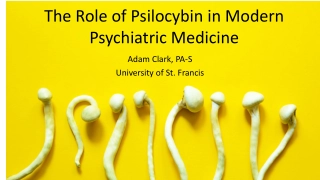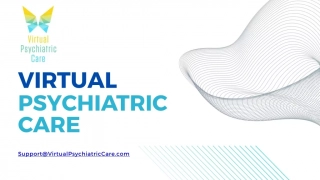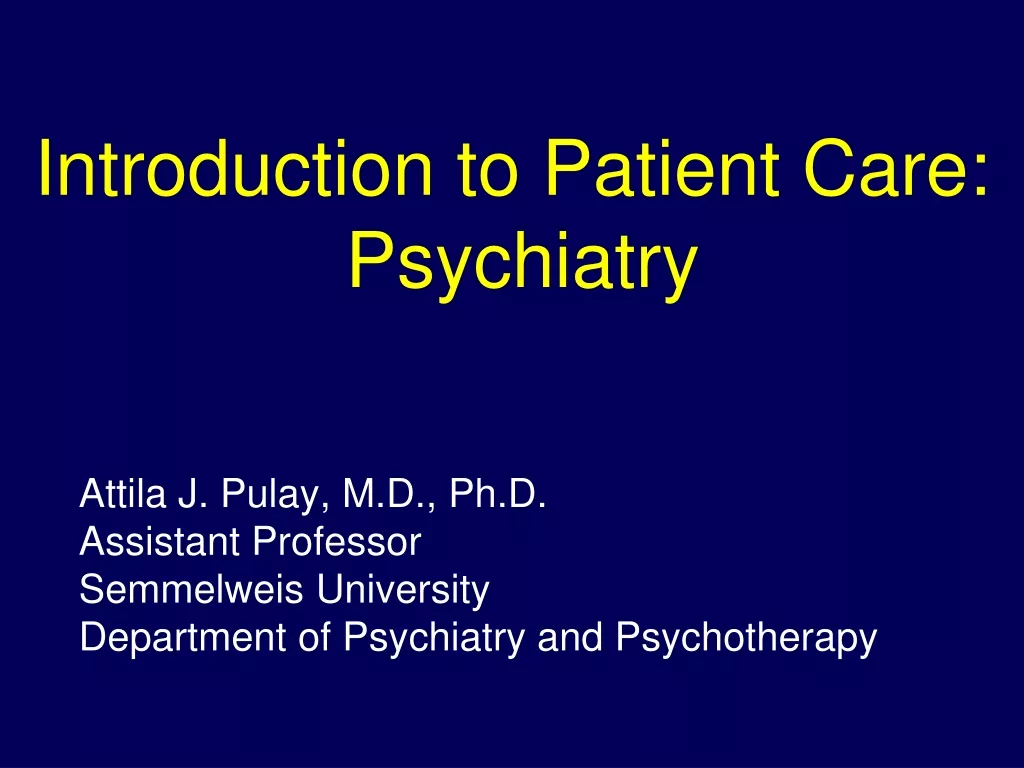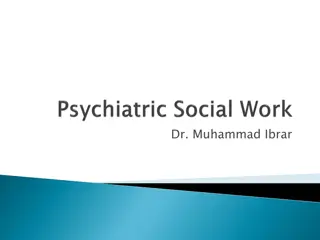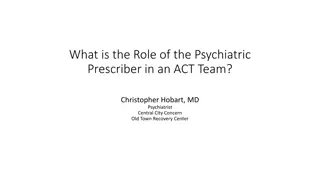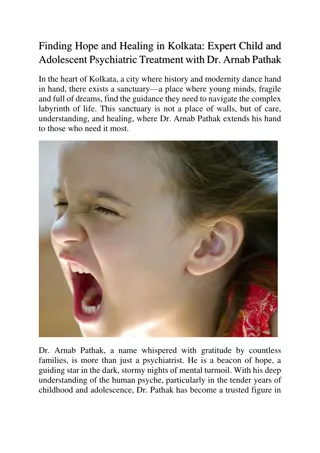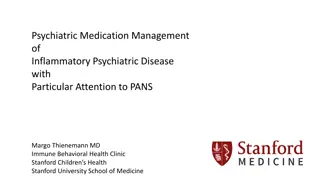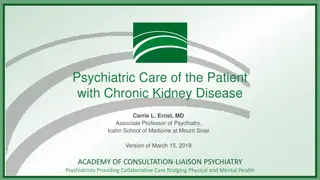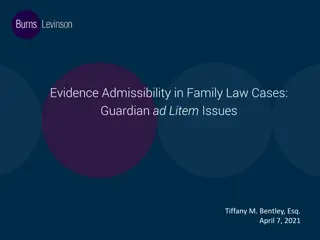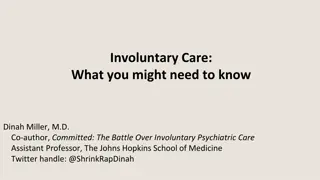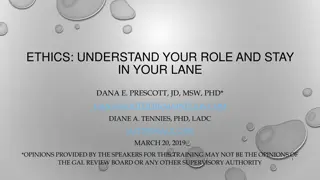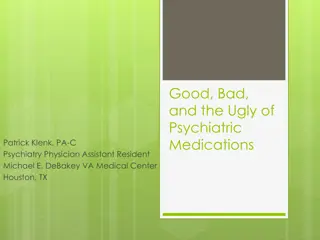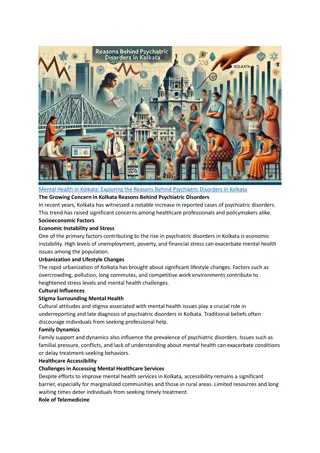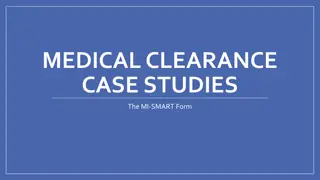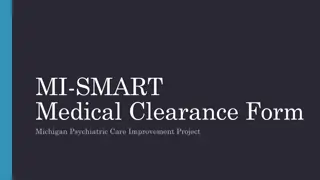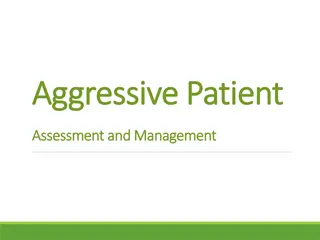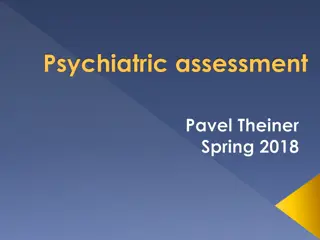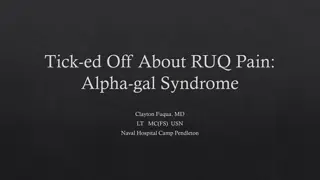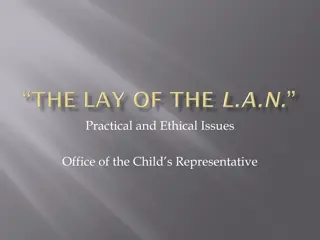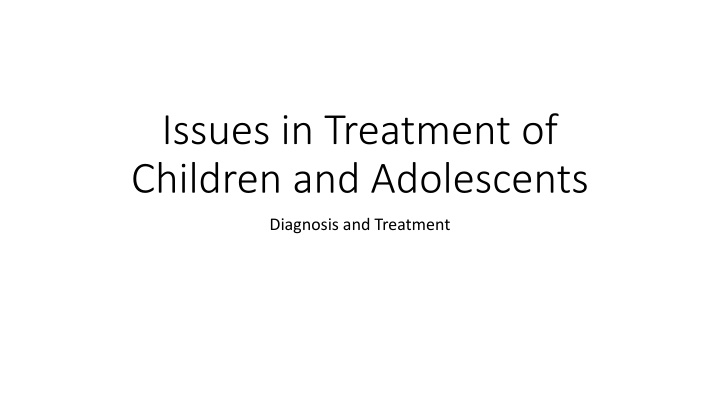
Pediatric Mental Health: Diagnosis and Treatment Challenges
Learn about the complexities in diagnosing and treating mental health issues in children and adolescents, including the common misdiagnosis of bipolar disorder as ADHD. Understand the symptoms of major depression and additional signs to look out for. Explore the challenges faced in identifying and managing mental health concerns in young individuals.
Download Presentation

Please find below an Image/Link to download the presentation.
The content on the website is provided AS IS for your information and personal use only. It may not be sold, licensed, or shared on other websites without obtaining consent from the author. If you encounter any issues during the download, it is possible that the publisher has removed the file from their server.
You are allowed to download the files provided on this website for personal or commercial use, subject to the condition that they are used lawfully. All files are the property of their respective owners.
The content on the website is provided AS IS for your information and personal use only. It may not be sold, licensed, or shared on other websites without obtaining consent from the author.
E N D
Presentation Transcript
Issues in Treatment of Children and Adolescents Diagnosis and Treatment
Be Careful A Diagnosis in Kids of Bipolar Disorder is often REALLY Attention-Deficit/Hyperactivity Disorder (ADHD)- A chronic condition including attention difficulty, hyperactivity, and impulsiveness. ADHD often begins in childhood and can persist into adulthood. It may contribute to low self-esteem, troubled relationships, and difficulty at school or work. Symptoms include limited attention and hyperactivity. Oppositional Defiant Disorder- Symptoms generally begin before a child is eight years old. They include irritable mood, argumentative and defiant behavior, aggression, and vindictiveness that last more than six months and cause significant problems at home or school.
Bipolar Disorder Since the mid 1990 s, the diagnosis of bipolar disorder has increased significantly; two-fold among adults, four-fold among adolescents, and forty-fold with children (Moreno et al., 2007). There is general agreement among mood-disorder experts that this has become the diagnosis du jour and most of these children do not have true bipolar disorder. According to renowned child psychiatrist John Walkup most children with emotional problems wiggle, squiggle and can t pay attention. Mood instability is a hallmark symptom of many psychiatric disorders and does not automatically imply a diagnosis of bipolar disorder.
Symptoms of Major Depression 5 or more symptoms (Adults) Depressed or irritable mood for more days than not Anhedonia (markedly diminished interest or pleasure in all or almost all activities, most days) Significant weight loss or gain (or failure to make expected weight gain) Insomnia or hypersomnia more days than not Psychomotor agitation or retardation nearly every day Fatigue more days than not Feelings of worthlessness or excessive guilt Impaired concentration Recurrent thoughts of death or suicide
Additional Diagnostic Signs and Symptoms of Major Depression in Children Irritability Social withdrawal Anhedonia-Inability to feel pleasure Low Self-esteem Themes of death, suicide, or self-destruction appearing in play Vegetative symptoms (feels as sleep disturbances or poor appetite)
Common Symptoms School failure Loneliness Sadness Low Energy Irritable Substance use Anger
Associated Signs and Symptoms Vague, nonspecific physical complaints Running away from home Boredom Extreme sensitivity to rejection Reckless behavior, acting out Difficulty with relationships Substance use or abuse (Lessen the electronics/social media)
Red Flags for Possible Bipolar Disorder Atypical depressive symptoms such as hypersomnia, severe fatigue, increased appetite, carbohydrate craving, weight gain Seasonal (winter) depression Psychotic symptoms (e.g., delusions) History of separation anxiety disorder History of Attention-deficit/hyperactivity disorder (ADHD) or ADHD- like symptoms Positive family history of bipolar disorder History of hypomania
Symptoms of Disruptive Mood Dysregulation Disorder Frequent (3 or more a week) and severe temper outbursts, grossly out of proportion in intensity and duration Persistent (nearly every day) anger and irritability Symptoms have been present for 12 months or more Not diagnosed for the first time before age 6 or after age 18 Absence of manic symptoms (and no history of manic symptoms)
Common Disorders that Present with Mood Instability Include the Following Diffuse brain damage (e.g. due to fetal alcohol exposure, traumatic brain injuries, etc.) Anxiety disorders Post-traumatic stress disorder Situational stress Reactive attachment disorders Agitated, unipolar depression Impaired affect regulation as a consequence of severe early abuse or neglect Psychotic disorders Some neurodevelopmental disorders Substance use disorder
Why such an increase in bipolar diagnoses? It is likely that more youngsters with the actual disorder are being identified and treated Bipolar disorder is misdiagnosed in youth (this is likely one of the main reasons that bipolar disorder is over diagnosed) There is a controversy and confusion among clinicians and researches regarding specific criteria making a bipolar diagnosis in children Standard treatments that have a positive track record with adults and older adolescents are not nearly as effective with prepubertal children
Bipolar 1, the Patient Must have Had at Least One Manic or Mixed Episode (DIGFAST/MANIA) Distractibility Impulsivity Grandiosity. In children this often presents as an overestimation of one s own abilities, which is a change from the child s normal behavior Flight of ideas Activities: Psychomotor Agitation Sleep Deficits (Decreased need for sleep) Talkativeness (Pressured sleep) Elevated or expansive mood. In children this often presents as significantly inappropriate or exaggerated silliness Risk taking behavior
Bipolar II Bipolar II Meets full DSM criteria for hypomania or mania, including duration, and displays classic elevated mood or grandiosity Meets the DSM symptom criteria for hypomania or mania, but not duration criteria, with hypomanic episodes lasting two to three days in length Meets duration criteria, but episodes are characterized by instability not euphoria
Signs and Symptoms of Early Signs and Symptoms of Early- -Onset Ma Onset Mania Chronic, not episodic Mixed states commonly occur with marked dysphoria and irritability Severe oppositional behavior Ultrarapid cycling Explosive outbursts or rage episodes
Bipolar Disorder and Attention Bipolar Disorder and Attention- - Deficit/hyperactivity Disorder (ADHD): Deficit/hyperactivity Disorder (ADHD): Irritability Inattention Hyperactivity Impulsivity High level of energy Pressured speech Symptoms are chronic and non episodic
Symptoms Common to Bipolar Disorder but Very Rare With ADHD Decreased need for sleep without daytime fatigue Intense, prolonged rage attacks (lasting 2-4 hours) Hypersexuality Flight of Ideas Morbid nightmares Psychotic symptoms Family history of obvious bipolar disorder or one or more of the following in blood relatives: Suicide Severe alcohol or drug abuse Multiple marriages Tendency to start numerous businesses
Anxiety Disorders Most common psychiatric condition in children (5-18%) Causes significant academic & social impairment Frequently persist into Adulthood Comorbid with Bipolar disorder and ADHD Includes: Obsessive Compulsive Disorder; Panic Disorder; Social Anxiety Disorder; Phobias; Post Traumatic Stress Disorder; Separation Anxiety Disorder
Symptoms Common with Anxiety Excessive Anxiety and worry for more days than not for at least 6 months Difficulty controlling worry 3 or more of the following: Restlessness/on edge; Easily fatigued; Difficulty concentrating; Irritability; Muscle tension; Sleep Disturbance Symptoms cause distress or impairment in social or other important areas of functioning Symptoms are not due to substance abuse or medical conditions
Obsessive-Compulsive Disorder Presence of Obsessions and/or Compulsion Recurrent and persistent thoughts, urges or images that are intrusive, unwanted, and generally cause marked anxiety or distress. Attempts to ignore / suppress thoughts, urges, or images, or to neutralize them with some thought or action (i.e., by performing a compulsion). The obsessions or compulsions are time consuming (> 1hr daily) or cause clinically significant distress or impairment. Good/Fair Insight: recognize behavior and lack of validity. Poor Insight: Behavior & beliefs are probably true. Absent Insight: Believe behavior and beliefs are true.
Panic Disorders A discrete period of intense fear or discomfort, in which four or more of the following symptoms developed abruptly and reached a peak within 10 minutes: Palpitations, pounding heart, or accelerated heart rate Sweating Trembling or shaking Sensations of shortness of breath or smothering Feeling of choking Chest pain or discomfort Nausea or abdominal distress Feeling dizzy, unsteady, lightheaded, or faint Derealization (feelings of unreality) or depersonalization (being detached from oneself) Fear of losing control or going crazy Fear of dying Paresthesia (numbness or tingling sensation) Chills or hot flushes.
Social Anxiety Disorder Marked fear or anxiety about social situations where the individual is exposed to possible scrutiny by others. In children, the anxiety must occur in peer groups and is out of proportion to the actual treat Fears that they will act in a way or show anxiety symptoms that will be negatively evaluated. Maybe expressed in crying, tantrums, freezing, clinging, shrinking, or failing to speak in social situations. Social situations cause great fear and can lead to avoidance and impairment. Last longer than 6 months
Phobias A specific phobia is an intense, persistent, irrational fear of a specific object, situation, or activity, or person. Usually, the fear is proportionally greater than the actual danger or threat. Provokes immediate fear or anxiety Object or situation is actively avoided or endured with intense fear or anxiety Impairment in social and other areas of functioning acrophobia, fear of heights. aerophobia, fear of flying. arachnophobia, fear of spiders. astraphobia, fear of thunder and lightning. autophobia, fear of being alone. claustrophobia, fear of confined or crowded spaces. hemophobia, fear of blood. hydrophobia, fear of water.
Post-Traumatic Stress Disorder Exposure to actual or threatened death, serious injury, or sexual violence in one (or more) of the following ways: Directly experiencing traumatic event(s). Witnessing in person, the event(s) as it occurred to others. Learning of traumatic event(s) occurred to a close individual. Repeated or extreme exposure to aversive details of the traumatic event(s).
PTSD Symptoms: vivid flashbacks (feeling like the trauma is happening right now) intrusive thoughts or images nightmares intense distress at real or symbolic reminders of the trauma physical sensations such as pain, sweating, nausea or trembling. avoiding anything that reminds you of the trauma being unable to remember details of what happened feeling emotionally numb or cut off from your feelings feeling physically numb or detached from your body being unable to express affection doing things that could be self-destructive or reckless using alcohol or drugs to avoid memories.
Separation Anxiety Disorder Developmentally inappropriate & excessive fear or anxiety concerning separation from those to whom the individual is attached, as evidenced by at least three of the following: When anticipating or experiencing separation from home or from major attachment figures. About losing major attachment figures or about possible harm to them, such as illness, injury, disasters, or death. About experiencing an untoward event (e.g., getting lost, being kidnapped, having an accident, becoming ill) that causes separation from a major attachment figure. Persistent reluctance or refusal to go out, away from home, to school, to work, or elsewhere because of fear of separation or to be alone or sleep away from home without being near major attachment figure.
Attention-Deficit/Hyperactivity Disorder Affects approximately 5 to 7 percent of children. As they mature neurologically, most teenagers with ADHD experience a noticeable reduction in motoric restlessness or hyperactivity, but the core symptoms of ADHD (impulsivity, impaired attention, and lack of intrinsic motivation) continue into adulthood. Most experts agree that about 40 percent of children with ADHD completely outgrow the disorder by early adulthood (likely due to the ongoing maturation of the prefrontal lobes. 60 percent experience ongoing symptoms throughout life
Differential Diagnosis of Childhood-Onset Psychiatric Disorders Presenting with ADHD Diffuse brain damage (such as that commonly seen in fetal alcohol syndrome, following a head injury, and so on). Anxiety Disorders Agitated depression Attachment disorders Situational stress Post-traumatic stress disorder Bipolar mania or hypomania Pre-psychotic conditions Impaired affect regulation with severe early abuse or neglect Substance use disorders Boredom (especially likely 111 bright children who are academically under stimulated)
Autism Spectrum Disorder Significant impairment in social interactions and communications Impairment in the use of nonverbal behaviors such as facial expression Failure to develop peer relationships appropriate to age A lack of spontaneous seeking to share interests with others Delayed or absent development of spoken language In individuals with adequate speech, impaired ability to converse with others Use of language in stereotyped or idiosyncratic ways Lack of make-believe play or imitative play appropriate to age Patterns of interests and activities: Intense preoccupation with one or more stereotyped and restricted patterns of interest Rigid adherence to nonfunctional routines or rituals Stereotyped and repetitive motor mannerisms Intense preoccupation with parts of objects
Autism Spectrum Disorders Aspergers Impairment in social relationships and repetitive and stereotyped patterns of behavior, but minimal delay in language development. People with Asperger's are interested in social relationships but are socially clumsy and insensitive. Distinguishing between high-functioning autism and Asperger's can be difficult.
Aspergers Disorder Diagnostic Features Qualitative impairment in social interaction with 2 of the following: Impairment in the use of nonverbal behaviors such as expression. Failure to develop peer relationships appropriate to age. Lack of spontaneous seeking to share interests with other people. Lack of social or emotional reciprocity. Stereotyped patterns of interests and activities as shown by the following: Intense preoccupation with one or more stereotyped and restricted patterns of interest Rigid adherence to nonfunctional routines or ritual Stereotyped and repetitive motor mannerisms Clinically significant impairment in social occupational, or other important areas of functioning. * NO Significant delay in language is seen.
Autism Spectrum Disorders Retts A condition characterized by its developmental course and development of neurological & behavioral symptoms. Predominately seen in females. All experience: Apparently normal prenatal and perinatal development, Apparently normal psychomotor development through the first 5 months after birth. Normal head circumference at birth. After period of normal development: Reduced head growth between 5 48 months Loss of previously developed hand skills between 5 and 30 months Loss of social engagement Development of poorly coordinated gate or trunk movements. Severely impaired language development.
Autism Spectrum Disorders - Childhood Disintegrative Disorder (Heller s Syndrome) Normal Development until at least 3 or 4 years. Deteriorate over a period of weeks or months, Significant los of language ability, social skills, intellectual functioning, and bowel or bladder control. After a period of deterioration, they stabilize and do not show further loss of function Predominantly seen in Males.
Autism Spectrum Disorders - Reactive Attachment Disorder of infancy or childhood. Not considered to be a neurodevelopmental disorder. Presumed developed as a response to early neglect. Withdrawal from caregivers Little expression of positive feeling Unexplained intense emotional reactions such as irritability, sadness, or fearfulness Rarely seek protection or comfort from caregivers
PSYCHOPHARMACOLOGY Treatment for children and Adolescents
Antidepressants -SSRI Generic Name Brand Name (mg) Starting Daily Dose (mg) Daily Dose Daily Dose (weight adj, mg/kg Fluoxetine 0.25- 0.75 Prozac Sarafem 5- 40 10-60 25-200 50-200 10-30 20-50 10-40 C : 5 A : 10 C: 25 A: 50 C:5 A: 10 C: 10 A:10 C: 5 A:5 C: 25 A: 25-50 1.5-3 Sertraline Zoloft .25-.75 Paroxetine Paxil 0.25-0.75 Citalopram Celexa 5: 20 5: 20 25-200 0.125-0.375 Escitalopram Lexapro 1.5-4.5 Fluvoxamine Luvox
Antidepressants SNRI; NRI Generic Name Brand Name (mg) Starting Daily Dose (mg) Daily Dose Daily Dose (weight adj, mg/kg Venlafaxine XR Effexor XR C: 25 A: 25 37.5 C: Not Established A: 50 C:Not Established A: 10 C: Not Established A:20 12.5- 37.5 25-75+ Not Established 1-2 Not Established Desvenlafaxine Pristiq Not Established 500-300 Not Established 1 Duloxetine Cymbalta 1 Levomilnacipran Fetzima NRI 10-60 40-100 1.2-1.8 C: 10 A: 40 Atomoxetine Strattera
Antidepressants NDRI; Atypical Generic Name Brand Name (mg) Starting Daily Dose (mg) Daily Dose Daily Dose (weight adj, mg/kg Bupropion SR Wellbutrin SR C: 100 A: 100 50-150 150-300 3-6 Atypical 50-30 15-45 25-75 25-100 Not Established 10-20 C:7.5 A: 15 C: 25 A: 50 C: Not Established A: 10 Not Established Mirtazapine Remeron 1 -3 Trazodone Desyrel 1.2-1.8 Vortioxetine Brintellix
Mood Stabilizers LITHIUM- The Gold Standard This is an established mood stabilizer, with a 50-80% response rate for bipolar I disorder in adults and adolescents. Positive outcomes with lithium in preadolescent bipolar patients are considerably lower. Lithium is approved by the FDA in children from 12-18 years of age. In adolescent's lithium is a first-line agent indicated for bipolar mania, bipolar depression, and prophylaxis. Lithium has unique features in its ability to significantly reduce suicide. This is important since bipolar disorder is associated with a very high rate of suicide.
Side Effects of Lithium Increased thirst Increased urination Possible nausea or vomiting Diarrhea, headache, tremors, weight gain, and worsening of acne Shaking
More Serious Side Effects of Lithium Changes in Kidney Function Hypothyroidism Cardiac conduction abnormalities Increased White Blood Cell Count This is why the use of Lithium requires ongoing medical and blood tests
Divalproex (Depakote)/Carbamazepine(Tegretol) Divalproex - is a first-line agent for mania and considered to be the preferred drug for mixed episodes in adults and adolescents. Carbamazepine - is a second-line medication for mania.
Lamotrigine (Lamictal) This is another first-line agent for bipolar depression in adolescents and adults Common side effects include nausea, vomiting, constipation, ataxia, and skin rash A serious side effect associated with Lamictal would be Stevens- Johnson syndrome
Antipsychotic Medications (Weight Gain) Quetiapine (Seroquel) Olanzapine (Zyprexa) Aripiprazole (Abilify) Risperidone (Risperdal) Lurasidone (Latuda) Vraylar- Great drug but new
Lithium Generic Name Starting Daily Dose Daily Dose Side Effects Lithium C: 15-30mg/Kg A: 600-1800 mg 3-4 Divided doses 3-4 Divided doses Sedation, thirst, GI intolerance, tremor, weight gain in 30- 40% of patients, hypothyroidism, increased urination, EKG changes
Divalproex (Depakote) Generic Name Starting Daily Dose Daily Dose Side Effects Depakote C/A:10-60mg/kg in 2-3 divided doses Sedation, dizziness, drowsiness, blurred vision, GI intolerance, hair loss, tremors
Lamotrigine (Lamictal) Generic Name Starting Daily Dose Daily Dose Side Effects Lamictal C: Do not use in Children/ As it may cause Stevens- Johnson syndrome A: Start at no more than 25mg/Day with gradual titration after 2 weeks Dizziness, headache, double vision, vomiting, and benign rash. Rare: Stevens- Johnson syndrome
Carbamazepine (Tegretol) Generic Name Starting Daily Dose Daily Dose Side Effects Tegretol C:10-20mg/kg A:400-800mg 3-4 divided doses 2-3 divided doses Sedation, dizziness, blurred vision, lack of coordination
ANXIETY MEDICATIONS Best treatment for Obsessive-Compulsive Disorder (OCD). -clomipramine (Anafranil), a TCA is also highly effective in treating OCD. -Exposure Therapy First line treatment includes: Prozac, Luvox, Zoloft, Celexa, Lexapro
Anxiety Medications Time Course Symptom Reduction 6-10 Weeks 18-24 Weeks 52 Weeks or more 25-30% Reduction 40-50% Reduction 50% or More
In general, doses used to treat OCD are higher than those needed to treat depression. Generic Name Brand Name Initial Dose Daily Dose Citalopram Clomipramine Celexa Anafranil C/A: 10mg C/A: 25mg C/A: 10-60mg C/A: 200mg or 3mg/kg whichever is lower C/A: 50-200mg (higher doses divided) C: 10mg Also higher weight children 20mg C: 25-200mg A: 50-200mg Fluvoxamine Luvox C/A: 25mg at bedtime Fluoxetine Prozac C/A: 10mg Daily Sertraline Zoloft C: 25mg daily A: 50mg daily

